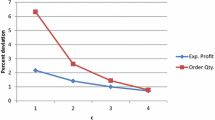Abstract
The newsvendor model is perhaps the most widely analyzed model in inventory management. In this single-period model, the only source of randomness is the demand during the period and one tries to determine the optimal order quantity in view of various cost factors. We consider an extention where supply is also random so that the quantity ordered is not necessarily received in full at the beginning of the period. Such models have been well-received in the literature with the assumption of independence between demand and supply. In this setting, we suppose that the random demand and supply are not necessarily independent. We focus on the resulting optimization problem and provide interesting characterizations on the optimal order quantity.

Similar content being viewed by others
References
Arifoğlu, K., Özekici, S.: Optimal policies for inventory systems with finite capacity and partially observed Markov-modulated demand and supply processes. Eur. J. Oper. Res. 204, 421–483 (2010)
Chopra, S.C., Sodhi, M.S.: Managing risk to avoid supply-chain breakdown. MIT Sloan Manag. Rev. 46, 53–61 (2004)
Chu, L.-K., Ni, J., Shi, Y., Xu, Y.: Inventory risk mitigation by financial hedging. In: Proceedings of the World Congress on Engineering and Computer Science (2009)
Ding, Q., Dong, L., Kouvelis, P.: On the integration of production and financial hedging decisions in global markets. Oper. Res. 55(3), 470–489 (2007)
Erdem, A., Özekici, S.: Inventory models with random yield in a random environment. Int. J. Prod. Econ. 78, 239–253 (2002)
Gallego, G., Hu, H.: Optimal policies for production/inventory systems with finite capacity and Markov-modulated demand and supply processes. Ann. Oper. Res. 126, 21–41 (2004)
Gaur, V., Seshadri, S.: Hedging inventory risk through market instruments. Manuf. Serv. Oper. Manag. 7, 103–120 (2005)
Gerchak, Y., Vickson, R.G., Parlar, M.: Periodic review production models with variable yield and uncertain demand. IIE Trans. 20, 144 (1988)
Grosfeld-Nir, A., Gerchak, Y.: Multiple lotsizing in production to order with random yields: review of recent advances. Ann. Oper. Res. 126, 43–69 (2004)
Henig, I.M., Gerchak, Y.: The structure of periodic review policies in the presence of random yield. Oper. Res. 38, 634–643 (1990)
Juttner, U.: Supply chain risk management: understanding the business requirements from a practitioner perspective. Int. J. Logist. Manag. 16, 120–141 (2005)
Karlin, S.: One stage model with uncertainty. In: Arrow, K.J., Karlin, S., Scarf, H. (eds.) Studies in the Mathematical Theory of Inventory and Production, pp. 109–143. Stanford University Press, Stanford (1958)
Kharif, O.: Motorola’s fuzzy camera-phone picture. Business Week, 11 December 2003
Noori, A.H., Keller, G.: The lot-size reorder-point model with upstream, downstream uncertainty. Decis. Sci. 17, 285–291 (1986)
Norrman, A., Jansson, U.: Ericsson’s proactive supply chain risk management approach after a serious sub-supplier accident. Int. J. Phys. Distrib. Logist. Manag. 34, 434–456 (2004)
Okyay, H.K., Karaesmen, F., Özekici, S.: Hedging demand and supply risks in the newvendor model. Tech. report, Koç University, Department of Industrial Engineering, Istanbul, Turkey (2011)
Özekici, M., Parlar, M.: Inventory models with unreliable suppliers in a random environment. Ann. Oper. Res. 91, 123–136 (1999)
Serel, D.A.: Inventory and pricing decisions in a single-period problem involving risky supply. Int. J. Prod. Econ. 116, 115–128 (2008)
Sethi, S.P., Cheng, F.: Optimality of $(s,{S})$ policies in inventory models with Markovian demand. Oper. Res. 45, 931–939 (1997)
Shih, W.: Optimal inventory policies when stockouts result from defective products. Int. J. Prod. Res. 18, 677–686 (1980)
Silver, E.A., Edward, A., Pyke, D.F., Peterson, R.: Inventory Management and Production Planning and Scheduling. Wiley, New York (1998)
Song, J.-S., Zipkin, P.: Inventory control with information about supply conditions. Manag. Sci. 42, 1409–1419 (1996)
Song, J.-S., Zipkin, P.: Inventory control in a fluctuating demand environment. Oper. Res. 41, 351–370 (1993)
Yano, C.A., Lee, H.L.: Lot sizing with random yields: a review. Oper. Res. 43, 311–334 (1995)
Acknowledgments
This research is supported by the Turkish Scientific and Technological Research Council through Grant 110M620. F. Karaesmen’s research is partially supported by the TÜBA-GEBİP programme.
Author information
Authors and Affiliations
Corresponding author
Rights and permissions
About this article
Cite this article
Okyay, H.K., Karaesmen, F. & Özekici, S. Newsvendor models with dependent random supply and demand. Optim Lett 8, 983–999 (2014). https://doi.org/10.1007/s11590-013-0616-7
Received:
Accepted:
Published:
Issue Date:
DOI: https://doi.org/10.1007/s11590-013-0616-7




